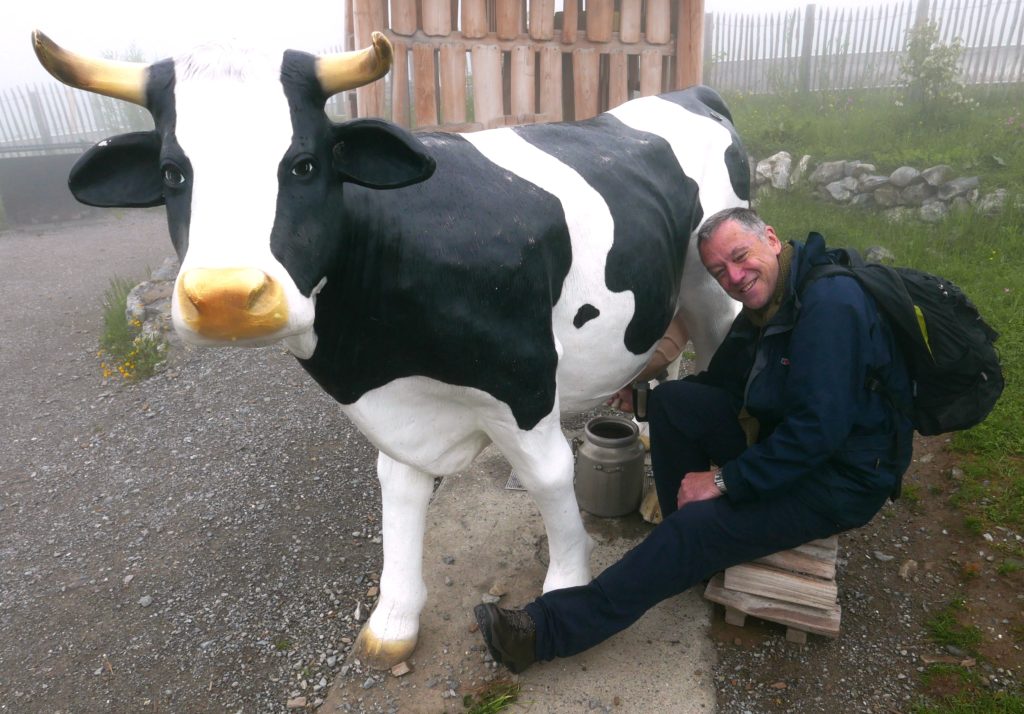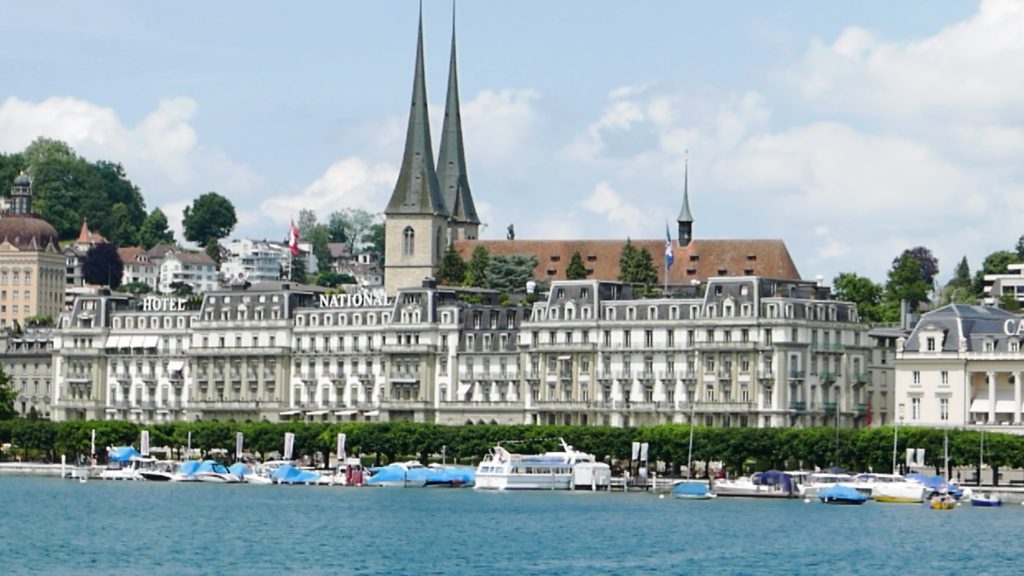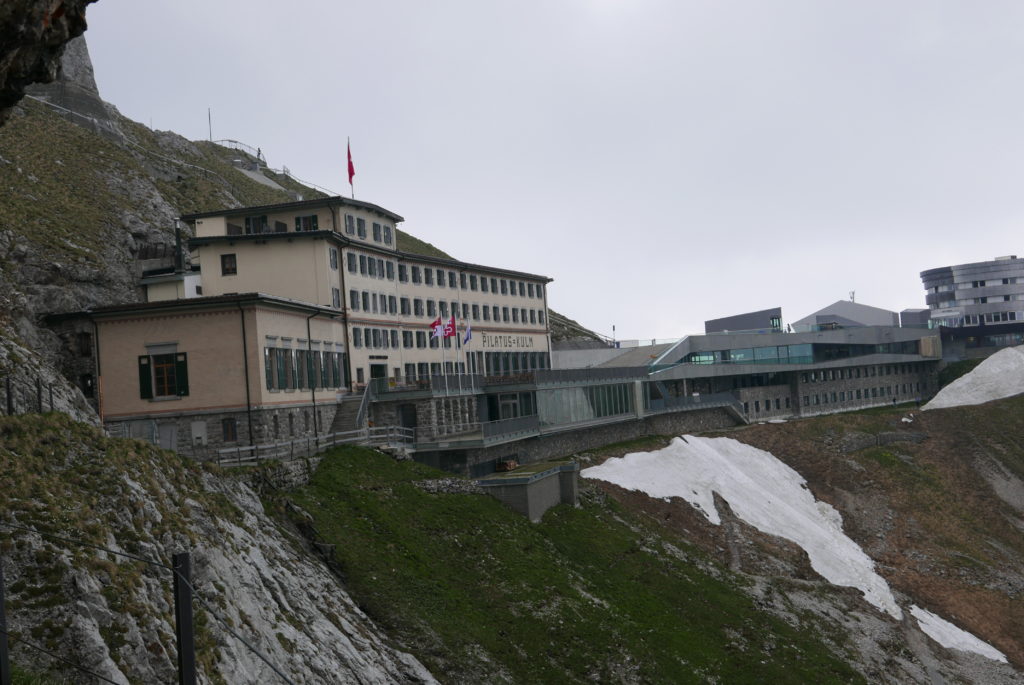AS I sat on a stool and began milking a cow, I could easily have been back in my uncle’s byre on the Atlantic coast of County Mayo on one of those long-ago school holidays.
But this was a long way from Ireland and any roaring ocean. In fact, I was up a mountain in Switzerland practising the art of milking on a fake – but, thankfully, smiling - cow in a children’s adventure playground.
Weird or what?
Happily, I avoided the possibility of being taken away by men in white coats due to the fact that my companion and guide for the day was the manager of the dramatic mountain ski lift which had taken us there.
And, as he pointed out, learning to milk by hand is as much a rite of passage for Swiss children as cross-country skiing, yodelling, eating bucket-loads of cheese and chocolate and talking as many languages as is humanly possible in a lifetime that averages around 80 years.
 James Ruddy gets to grips with cow milking
James Ruddy gets to grips with cow milkingIt’s no surprise to learn that this picture postcard of a country has been an increasing magnet for tourists for a couple of centuries, with the Chinese and Indians more recently joining the regulars from across Europe and North America.
Having broken far too many bones without ever learning to ski, it has taken me over half a century to get around to the fact that the place has far more to offer than just pootling down the white stuff with flimsy bits of stick attached to your hands and feet.
Out of the ski season, there is an incredible array of things to see and do, as I found on a four-day break in and around the pretty medieval watering hole of Lucerne, where the gloriously blue lake of the same name is ringed by soaring white-capped mountains.
 The lovely city of Lucerne, which is surrounded by snow-capped mountains, makes a great place for a short break
The lovely city of Lucerne, which is surrounded by snow-capped mountains, makes a great place for a short breakApart from the ‘highlight’ of milking fake cattle, I was also able to squeeze in a guided walk around the ancient streets, a museum tour, a couple of mountain hikes, an adrenalin-pumping rope park session, cheese-tasting and some fabulous local meals.
Old hands will, of course, have long forgotten that first thrill that I felt of stepping onto a spotless and half empty red train at Zurich Airport Station and finding my way on to the top deck as it departed on time and sliced through soaring green and white countryside of meadows and snow-capped mountains, dotted with intricately-carved wooden houses and contended-looking real cows.
Less than an hour’s ride away, lovely Lucerne has long been the gateway city for travellers heading into Central Switzerland, partly thanks to the arrival there in 1868 of a rather grim-looking woman dressed totally in black, whose image is capturing a great deal of attention there this summer.
Marking 150 years since the five-week visit of Queen Victoria – then the world’s most powerful woman as empress of a quarter of its people – Lucerne history museum is presenting six months of linked events, from special Victorian teas to re-creations of her stays at hotels in the area.
The events are a tribute to the allegedly secret royal visit – well-known to much of Europe at the time – which is credited with opening up the tourism of Lucerne and Central Switzerland to a mass of new visitors, who have continued to pour in ever since.
 Lucerne, pictured from the lake (Picture: Markus Buehler)
Lucerne, pictured from the lake (Picture: Markus Buehler)Before then, its watering holes were largely the domain of Europe’s well-heeled gentry. And now, although remaining one of the top five most expensive countries in the world to visit, its tourist industry has adapted to cater for the less affluent.
Hence, on Lucerne’s ancient streets, I encountered a mixture of designer-clothed American, European, Indian and Chinese visitors, as well as plenty of dusty backpackers and even whole foreign families, sharing home-made sandwiches on park benches to cut their spending
If costs are an issue, there are plenty of deals with UK cut-price flight operators, as well as last-minute and all-inclusive packages, which reduce the potentially hefty spending on accommodation, food and drink, as well as tours and guides.
Some holiday treats, though, are well worth splashing out on. One of my best meals was also relatively good value: the wonderfully tasty local speciality Lucerne Chugelipastete, which is a pastry shell veal pie surrounded by fresh vegetables and topped with an optional sauce of raisins pickled in cognac.
With a glass of merlot at a decent local restaurant, it cost 40 Swiss Francs (£30), but was preceded by plenty of tasty nibbles and fruit.
A guided tour is always worth the cost, if only to get your bearings and a local’s insight into some of the quirky and hidden aspects of your base.
So it was with my walking tour by Lucerne Tourism specialist Hanny Fielder, a real power-pack, who whistled me through hundreds of years of history, from the Wallis Villa where the great queen stayed to the many fabulous murals which tell the city’s story from being a river-based transport centre to today’s world-renowned tourist trap.
 A range of off-season activities, such as spending some time on the water, can be enjoyed in Switzerland
A range of off-season activities, such as spending some time on the water, can be enjoyed in SwitzerlandMy base for a couple of nights was the Anker Hotel, which is being refurbished as a very cool dining and sleeping place in an ancient building which is so central that even I managed to not get lost once.
Further afield, I was introduced to one of the ‘hidden’ secrets out of the ski season – the lovely Engleberg resort, just 45 minutes by train and renowned for its stunning mountain and meadow scenery.
A major draw there is the village’s cheese factory, which is located in the local monastery and allows you to watch the whole process through glass walls, as stainless steel vats produce such famed Swiss favourites as Engelberg Monastery Bell Cheese – named after the original bell which was recovered and replaced after a huge fire and now sits on a nearby lawn, never to ring again.
A curious addition to the factory’s products is the very mild Cheddar which was so beloved of Queen Victoria and brought with her from England. The factory manager has discovered the recipe and technique and is now producing and selling huge quantities of what may well be named eventually, ‘Queen Victoria’s Cheddar’.
Just my luck, Engelberg experienced one of its occasional days of heavy mountain mists which led to my worrying six-hour guided uphill hike being cancelled (phew, that was a close shave). I took the more relaxing cable car ride up to the Brunni Hut Alpine restaurant for a waist-bursting meal of another local favourite, pasta in a thick cheese sauce, topped off with crispy onions and apple sauce.
After a look round the adventure playground, I was soon back on the train and in Lucerne for a museum tour of the Queen Victoria exhibition before dinner on the riverbank at the trendy Hotel Des Alpes, with a jazz ensemble in the background and an exquisite veal steak and roast vegetables in front of me.
Drinks later included a bottle of the local Quollfrisch naturtrub (try to pronounce that after a couple), which is a fruity Pilsener malt beer with a lively and yeasty character. After three bottles, I retired to bed despite planning to grab a Guinness at the Shamrock Irish pub round the corner. Unlike many around the world, it is owned and run by an Irish landlord and is well-placed near the river and the main railway station.
Next day, after the typical hearty Swiss hotel breakfast (museli, cheese and bread, sausage, a fry-up and, of course, some fruit and coffee), I was checking out and onto the bus across the road for nearby Kriens and my assault on the major peak of Pilatus.
It seems Queen Victoria, not the lithest of figures, managed to get up this 7000-footer, as well as a few others during her five week-stay, so I was full of confidence – especially when I found I would not be replicating her wobbly horseback expedition, but would be riding the stunning cable car instead.
The views were staggering – and very soon, so too was I, as I had also booked myself onto the Rope Park, one of the biggest in Switzerland and filled with challenges at a variety of heights and difficulty levels.
I opted for the yellow challenge which is favoured by small children, but then graduated up to the mid-range pink level, which had me walking across some wobbly pieces of wood and doing the splits (there go the Rohan pants again) 30 feet above the park office.
After whizzing through a few zip lines and vertical drops, it all felt reassuringly safe, due to the instructors’ detailed briefings and the high quality ropes and climbing gear.
Next came a very picturesque ‘Dragon Ride’ aerial cableway ride up to the summit hotel, the Pilatus Kulm, at 2132 metres, which opened in 1890 and was completely renovated only eight years ago.
 The Hotel Pilatus is well worth a visit
The Hotel Pilatus is well worth a visitThe spacious terrace was packed with day trippers from across the world, eating, drinkjing and taking selfies that included some amazing views in three directions across to the distant Alps and to Lucerne and the lake below.
By tea-time, they had disappeared like a swarm of bees heading for the hive, leaving me and a half dozen fellow guests alone to enjoy the solitude and peace of true alpine beauty. I took the 40-minute flower walk across to a nearby peak, encountering three long-horned Ibis on the way (they hopped off the path thankfully) before a fine dining experience in the Victoria Restaurant that featured my first (and probably last) roast ostrich steak.
Pilatus was definitely the ‘peak’ of my visit, with its amazing scenery, walks, food and true Alpine hotel comforts, but the journey down the other side the next morning capped it all.
The trip was made on the world’s steepest cogwheel train, which takes around 40 minutes and includes stretches at a knee-knocking 45 degrees through tunnels and across steep cliffs before reaching Alpnachstad station and the ferry pier for the glorious boat trip across Lake Lucerne.
 The world's steepest cogwheel railway is found in Switzerland (Picture: Stefan Schlumpf)
The world's steepest cogwheel railway is found in Switzerland (Picture: Stefan Schlumpf)As locals sipped white wine at tables on the open rear deck, I was drinking in this incredible vista of soaring mountains and tiny village stopping points to drop off and pick up passengers. It was a kaleidoscope experience of a bygone and far gentler age.
It’s no surprise that that very discerning of Irishmen, James Joyce, once chose to live in Switzerland, where he is said to have proclaimed that Zurich’s Bahnhofstrasse was so clean you could drink minestrone off the pavement.
Of course, that was over a century ago, when the great writer was seeking a neutral haven from the First World War and for a similar reason when he fled there again from Nazi-occupied France in 1940.
As I stepped onto the train back to the airport, it was easy to understand why that other ‘celebrity’ of her day, Queen Victoria, dressed in black and in mourning still after the death from typhoid of her beloved Albert seven years earlier, had chosen this heavenly place to restore her broken heart.
If Lucerne and its fierce natural beauty and plethora of cultural and active pursuits cannot lift your spirits in this busy modern world, nowhere can.
Planning a visit?
For more information about visiting Switzerland click here, call the Switzerland Travel Centre on freephone 00800 100 200 30 or email [email protected].
For packages, trains and air tickets email [email protected].
Swiss International Air Lines offers more than 180 weekly flights from London City, Heathrow, Gatwick (seasonal), Manchester, Birmingham, Edinburgh and Dublin to Zurich, Geneva or Sion (seasonal). All-inclusive fares start from £74 one-way. For more information click here or call 0345 601 0956.
The Swiss Travel System provides a dedicated range of travel passes and tickets exclusively for visitors from abroad.The Swiss Transfer Ticket covers a round-trip between the airport/Swiss border and destination. Prices are £112 in second class and £182 in first class.
The Swiss Travel Pass is the all-in-one ticket to travel by train, bus and boat on an all-inclusive basis from 3-15 days. Prices from £172 in second class. Each ticket also offers free admission to more than 500 museums nationwide and half-price on the most scenic Swiss mountain railways.
For the ultimate Swiss rail specialist call Switzerland Travel Centre on 00800 100 200 30.

